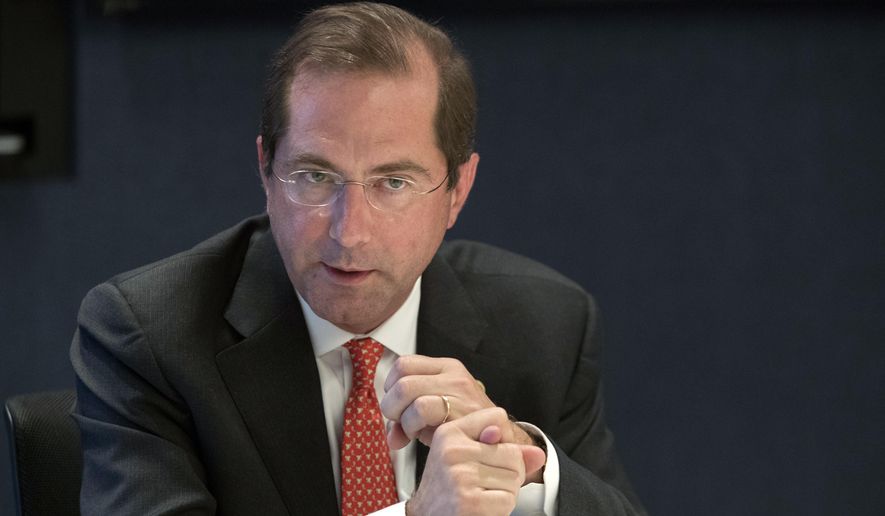Average premiums for key Obamacare benchmark plans are set to drop for the first time in the program’s history, Health and Human Services Secretary Alex Azar said Thursday, challenging Democrats’ claims that the Trump administration had “sabotaged” the law.
Mr. Azar said insurers that will sell plans on the HealthCare.gov website next year requested rates that are 2 percent lower than this year for the benchmark policies.
Although the reduction is small, it marks the first time that the market has avoided big increases.
Mr. Azar also said the number of insurers offering plans will increase next year for the first time since 2015.
“Let me repeat that: Under President Trump, premiums are dropping and choices are returning,” Mr. Azar said at Lipscomb University in Nashville, Tennessee. “The president who was supposedly trying to sabotage the Affordable Care Act has proven better at managing it than the president who wrote the law.”
The reasons for the brighter Obamacare picture are heatedly debated.
Trump opponents said the tweaks he and fellow Republicans made to the Affordable Care Act have siphoned away healthy customers, damaging the law’s economic underpinnings.
“Today’s appearance officially makes Secretary Azar Donald’s Trump latest snake oil salesman,” said Leslie Dach, chairman of Protect Our Care, a pro-Obamacare group.
The benchmark plans are the second-lowest cost “silver” plans offered on the Obamacare exchanges.
They set the level of subsidies that the government pays under Obamacare, and the drop in premiums signals that taxpayers stand to benefit from the decrease.
An Avalere Health/Associated Press analysis found that average premiums across the individual market, which goes beyond the exchanges, should rise by a modest 3.1 percent next year.
Plans are starting to make money after demanding high rates for this year, when they were still grappling with an uncertain political climate and customer base that was sicker than expected in the early rounds.
“A lot of the same factors that are holding down premiums across the country apply here [to benchmark plans]. Health insurers have started to figure out this market,” said Chris Sloan, a director at Avalere Health.
Benchmark plans, in particular, may be seeing notable changes because they spiked so much this year — an offshoot of Mr. Trump’s decision not to pay “cost-sharing” reimbursements unless Congress gave him permission. States loaded premium increases on the benchmark plans to boost subsidies but are adjusting to the new climate this time.
“They already took the increase last year and don’t have to take the big increase this year,” Mr. Sloan said.
Analysts said the growing number of plans is a reflection of insurers’ confidence about the marketplace after calls for repeal of Obamacare receded.
“When insurers don’t know what’s going on, they either raise rates or run like hell, and that’s what happened in ’18,” said David Anderson, a research associate at the Margolis Center for Health Policy at Duke University.
Analysts said Mr. Trump deserves full credit, however, for cheering on state reinsurance programs, in which money is set aside to blunt the costs of extra-pricey customers so the rest of the market can pay less in premiums.
In his speech, Mr. Azar highlighted Mr. Trump’s work on reinsurance and his push to stabilize the market in early 2017 by cutting the enrollment period in half and tightening rules on “special enrollment periods” that let customers drop in and out of the market outside the regular sign-up season.
Whatever the cause, the drop in benchmark premiums is good news for taxpayers who help customers earning up to 400 percent of poverty pay for their Obamacare plans. As subsidies rose with spiking rates last year, taxpayers had to shell out more money even as enrollment remained static.
“Taxpayers are paying less” next year, Mr. Sloan said, assuming enrollment remains flat. “This is a big deal because this hasn’t happened before.”
Democrats say enrollees should be paying less too. After Republicans tried and failed to replace Obamacare with a better system last year, they settled for a repeal of penalties tied to the “individual mandate” that required Americans to get covered or pay a tax.
Insurers cited repeal of the mandate, which was designed to prod healthy people into the market, and Mr. Trump’s decision to extend the reach of “association” plans and “short-term” plans that don’t fully comply with Obamacare’s coverage rules as reasons they had to request higher rates.
“Without repeal of the individual mandate penalty and expansion in loosely regulated short-term plans that will siphon off healthy people from the ACA market, premiums would be going down even further,” said Larry Levitt, senior vice president at the Kaiser Family Foundation.
Still, the outlook is not as bad as Democrats said it would be, and unsubsidized customers are still reeling from premium increases that have compounded each year since Obamacare’s launch in 2014.
Mr. Azar said the administration wants Congress to make another attempt at repeal if Republicans stave off a “blue wave” and gain seats in the midterm elections.
“The president has managed to stabilize rates, but the underlying premiums are still unaffordable for Americans who don’t qualify for the law’s generous subsidies,” Mr. Azar said. “The ACA is not ’fixed’ or even ’fixable’ without Congress’ repealing and replacing it.”
Liberal Democrats are running in the opposition direction, saying Congress needs to explore a government-run, single-payer system that insures everyone, including those left behind by Obamacare.
Mr. Azar went out of his way to blast the idea — often dubbed “Medicare for all” — in his speech Thursday. He said it would force taxpayers to foot its “staggering costs,” undercut public insurance for seniors and amplify one of the 2010 Affordable Care Act’s noted foibles.
• Tom Howell Jr. can be reached at thowell@washingtontimes.com.




Please read our comment policy before commenting.